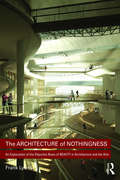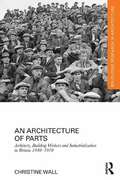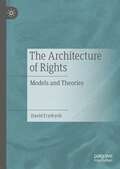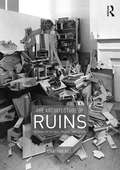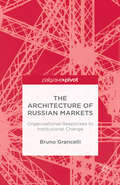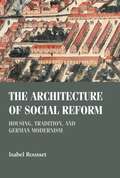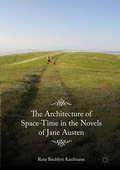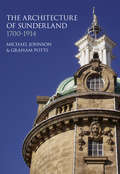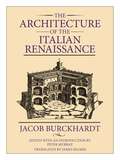- Table View
- List View
The Architecture of Nothingness: An Explanation of the Objective Basis of Beauty in Architecture and the Arts
by Frank LyonsIt is a common enough assumption that good buildings make us feel good just as poor ones can make us feel insecure, depressed or even threatened. We may instantly decide that we ‘like’ one building more than another, in the same way that without thinking we choose one work of art or music over another. But what is going on when we make these instant decisions? The process is so complex that it remains an area rarely examined, often considered unfathomable, or for some mysterious, bordering even on the spiritual. Frank Lyons seeks to unpick the complex relationships that go to make up great works of architecture, to reveal a set of principles that are found to apply not only to architecture but also to art, music and culture in general. One of the major complications at the heart of culture is that because the arts are generated subjectively, it is assumed that the finished cultural artefact is also subjective. This is a myth that this book seeks to dispel. The arts are indeed created from the personal subjective space of an individual but what that individual has to say will only be shareable if expressed in coherent (objective) form. In a nutshell, the book reverses two generally accepted positions, that the arts are subjective and that meaning is objective and therefore shared. The reversal of these seemingly common sense, but mistaken positions enables two important issues to be resolved, firstly it explains how the arts communicate through objectivity and secondly how the meaning of an object of art is never shared but always remains private to the individual. The combination of these two positions ultimately helps us to understand that beauty is a subjective appreciation of an objectively arranged form. Furthermore, this understanding enables the author to explain how a sublimely arranged form can open us to the ineffable; to a field of NOTHINGNESS, or to what some might call the spiritual realm of our own being.
The Architecture of Nothingness: An Explanation of the Objective Basis of Beauty in Architecture and the Arts
by Frank LyonsIt is a common enough assumption that good buildings make us feel good just as poor ones can make us feel insecure, depressed or even threatened. We may instantly decide that we ‘like’ one building more than another, in the same way that without thinking we choose one work of art or music over another. But what is going on when we make these instant decisions? The process is so complex that it remains an area rarely examined, often considered unfathomable, or for some mysterious, bordering even on the spiritual. Frank Lyons seeks to unpick the complex relationships that go to make up great works of architecture, to reveal a set of principles that are found to apply not only to architecture but also to art, music and culture in general. One of the major complications at the heart of culture is that because the arts are generated subjectively, it is assumed that the finished cultural artefact is also subjective. This is a myth that this book seeks to dispel. The arts are indeed created from the personal subjective space of an individual but what that individual has to say will only be shareable if expressed in coherent (objective) form. In a nutshell, the book reverses two generally accepted positions, that the arts are subjective and that meaning is objective and therefore shared. The reversal of these seemingly common sense, but mistaken positions enables two important issues to be resolved, firstly it explains how the arts communicate through objectivity and secondly how the meaning of an object of art is never shared but always remains private to the individual. The combination of these two positions ultimately helps us to understand that beauty is a subjective appreciation of an objectively arranged form. Furthermore, this understanding enables the author to explain how a sublimely arranged form can open us to the ineffable; to a field of NOTHINGNESS, or to what some might call the spiritual realm of our own being.
An Architecture of Parts: Architects, Building Workers and Industrialisation in Britain 1940 - 1970 (Routledge Research in Architecture)
by Christine WallThis book is unique in describing the history of post war reconstruction from an entirely new perspective by focusing on the changing relationship between architects and building workers. It considers individual, as well as collective, interactions with technical change and in doing so brings together, for the first time, an extraordinary range of sources including technical archives, oral history and visual material to describe the construction process both during and in the decades after the war. It focuses on the social aspects of production and the changes in working life for architects and building workers with increasing industrialization, in particular analysing the effect on the building process of introducing dimensionally co-ordinated components. Both architects and building workers have been accused of creating a built environment now popularly discredited: architects responsible for poor design and building workers for poor workmanship. However, many of the structures and ideas underpinning this period of rapid change were revolutionary in their commitment to a complete transformation of the building process. An Architecture of Parts adds to the growing literature on changes in the building world during and immediately after the Second World War. It is significant, both empirically and historically, in its examination of the ideas, technology and relationships that fired industrialization of the building process in mid-century Britain.
An Architecture of Parts: Architects, Building Workers and Industrialisation in Britain 1940 - 1970 (Routledge Research in Architecture)
by Christine WallThis book is unique in describing the history of post war reconstruction from an entirely new perspective by focusing on the changing relationship between architects and building workers. It considers individual, as well as collective, interactions with technical change and in doing so brings together, for the first time, an extraordinary range of sources including technical archives, oral history and visual material to describe the construction process both during and in the decades after the war. It focuses on the social aspects of production and the changes in working life for architects and building workers with increasing industrialization, in particular analysing the effect on the building process of introducing dimensionally co-ordinated components. Both architects and building workers have been accused of creating a built environment now popularly discredited: architects responsible for poor design and building workers for poor workmanship. However, many of the structures and ideas underpinning this period of rapid change were revolutionary in their commitment to a complete transformation of the building process. An Architecture of Parts adds to the growing literature on changes in the building world during and immediately after the Second World War. It is significant, both empirically and historically, in its examination of the ideas, technology and relationships that fired industrialization of the building process in mid-century Britain.
The Architecture of Percier and Fontaine and the Struggle for Sovereignty in Revolutionary France
by Iris MoonAs the official architects of Napoleon, Charles Percier (1764–1838) and Pierre-François-Léonard Fontaine (1762–1853) designed interiors that responded to the radical ideologies and collective forms of destruction that took place during the French Revolution. The architects visualized new forms of imperial sovereignty by inverting the symbols of monarchy and revolution, constructing meeting rooms resembling military encampments and gilded thrones that replaced the Bourbon lily with Napoleonic bees. Yet in the wake of political struggle, each foundation stone that the architects laid for the new imperial regime was accompanied by an awareness of the contingent nature of sovereign power. Contributing fresh perspectives on the architecture, decorative arts, and visual culture of revolutionary France, this book explores how Percier and Fontaine’s desire to build structures of permanence and their inadvertent reliance upon temporary architectural forms shaped a new awareness of time, memory, and modern political identity in France.
The Architecture of Percier and Fontaine and the Struggle for Sovereignty in Revolutionary France
by Iris MoonAs the official architects of Napoleon, Charles Percier (1764–1838) and Pierre-François-Léonard Fontaine (1762–1853) designed interiors that responded to the radical ideologies and collective forms of destruction that took place during the French Revolution. The architects visualized new forms of imperial sovereignty by inverting the symbols of monarchy and revolution, constructing meeting rooms resembling military encampments and gilded thrones that replaced the Bourbon lily with Napoleonic bees. Yet in the wake of political struggle, each foundation stone that the architects laid for the new imperial regime was accompanied by an awareness of the contingent nature of sovereign power. Contributing fresh perspectives on the architecture, decorative arts, and visual culture of revolutionary France, this book explores how Percier and Fontaine’s desire to build structures of permanence and their inadvertent reliance upon temporary architectural forms shaped a new awareness of time, memory, and modern political identity in France.
An Architecture of Place: Topology in Practice
by Randall S. LindstromChallenging mainstream architecture’s understandings of place, this book offers an illuminating clarification that allows the idea’s centrality, in all aspects of everyday design thinking, to be rediscovered or considered for the first time.Rigorous but not dense, practical but not trivialising, the book unfolds on three fronts. First, it clearly frames the pertinent aspects of topology—the philosophy of place—importantly differentiating two concepts that architecture regularly conflates: place and space. Second, it rejects the ubiquitous notion that architecture “makes place” and, instead, reasons that place is what makes architecture and the built environment possible; that place “calls” for and to architecture; and that architecture is thus invited to “listen” and respond. Finally, it turns to the matter of designing responses that result not just in more places of architecture (demanding little of design), nor merely in architecture with some “sense of place” (demanding little more), but, rising above those, responses that constitute an architecture of place (demanding the greatest vigilance but offering the utmost freedom).Opening up a term regarded as so common that its meaning is seldom considered, the author reveals the actual depth and richness of place, its innateness to architecture, and its essentiality to practitioners, clients, educators, and students—including those in all spatial disciplines.
An Architecture of Place: Topology in Practice
by Randall S. LindstromChallenging mainstream architecture’s understandings of place, this book offers an illuminating clarification that allows the idea’s centrality, in all aspects of everyday design thinking, to be rediscovered or considered for the first time.Rigorous but not dense, practical but not trivialising, the book unfolds on three fronts. First, it clearly frames the pertinent aspects of topology—the philosophy of place—importantly differentiating two concepts that architecture regularly conflates: place and space. Second, it rejects the ubiquitous notion that architecture “makes place” and, instead, reasons that place is what makes architecture and the built environment possible; that place “calls” for and to architecture; and that architecture is thus invited to “listen” and respond. Finally, it turns to the matter of designing responses that result not just in more places of architecture (demanding little of design), nor merely in architecture with some “sense of place” (demanding little more), but, rising above those, responses that constitute an architecture of place (demanding the greatest vigilance but offering the utmost freedom).Opening up a term regarded as so common that its meaning is seldom considered, the author reveals the actual depth and richness of place, its innateness to architecture, and its essentiality to practitioners, clients, educators, and students—including those in all spatial disciplines.
Architecture of Regionalism in the Age of Globalization: Peaks and Valleys in the Flat World
by Liane Lefaivre Alexander TzonisThe definitive introductory book on the theory and history of regionalist architecture in the context of globalization, this text addresses issues of identity, community, and sustainability along with a selection of the most outstanding examples of design from all over the world. Alex Tzonis and Liane Lefaivre give a readable, vivid, scholarly account of this major conflict as it relates to the design of the human-made environment. Demystifying the reasons behind how globalization enabled creativity and brought about unprecedented wealth but also produced new wastefulness and ecological destruction, the book also looks at how regionalism has also tended to confine, tearing apart societies and promoting destructive consumerist tourism.
Architecture of Regionalism in the Age of Globalization: Peaks and Valleys in the Flat World
by Liane Lefaivre Alexander TzonisThe definitive introductory book on the theory and history of regionalist architecture in the context of globalization, this text addresses issues of identity, community, and sustainability along with a selection of the most outstanding examples of design from all over the world. Alex Tzonis and Liane Lefaivre give a readable, vivid, scholarly account of this major conflict as it relates to the design of the human-made environment. Demystifying the reasons behind how globalization enabled creativity and brought about unprecedented wealth but also produced new wastefulness and ecological destruction, the book also looks at how regionalism has also tended to confine, tearing apart societies and promoting destructive consumerist tourism.
Architecture of Regionalism in the Age of Globalization: Peaks and Valleys in the Flat World
by Liane Lefaivre Alexander TzonisThis book remains the definitive introductory text on the theory and history of regionalist architecture in the context of globalization. It addresses issues of identity, diversity, community, inequality, geopolitics, and sustainability. From the authors who coined the concept of Critical Regionalism, this new edition enhances the understanding of the complex evolution of regionalism and its rival, unchecked globalization. Covering a rich selection of the most outstanding examples of design from all over the world, Liane Lefaivre and Alexander Tzonis, who introduced the concept of Critical Regionalism to architecture, present an enlightening, concise historical analysis of the endurance of regionalism and the ceaseless drive for globalization. New case studies include current cutting-edge projects in Japan, Africa, China, and the United States. Architecture of Regionalism in the Age of Globalization offers undergraduate and graduate students of architecture, geography, history, environmental studies, and other related fields an accessible, vivid, and scholarly perspective of this major conflict as it relates to the design and to the future of the human-made environment.
Architecture of Regionalism in the Age of Globalization: Peaks and Valleys in the Flat World
by Liane Lefaivre Alexander TzonisThis book remains the definitive introductory text on the theory and history of regionalist architecture in the context of globalization. It addresses issues of identity, diversity, community, inequality, geopolitics, and sustainability. From the authors who coined the concept of Critical Regionalism, this new edition enhances the understanding of the complex evolution of regionalism and its rival, unchecked globalization. Covering a rich selection of the most outstanding examples of design from all over the world, Liane Lefaivre and Alexander Tzonis, who introduced the concept of Critical Regionalism to architecture, present an enlightening, concise historical analysis of the endurance of regionalism and the ceaseless drive for globalization. New case studies include current cutting-edge projects in Japan, Africa, China, and the United States. Architecture of Regionalism in the Age of Globalization offers undergraduate and graduate students of architecture, geography, history, environmental studies, and other related fields an accessible, vivid, and scholarly perspective of this major conflict as it relates to the design and to the future of the human-made environment.
The Architecture of Rights: Models and Theories
by David FrydrychWhat is a right? What, if anything, makes rights different from other features of the normative world, such as duties, standards, rules, or principles? Do all rights serve some ultimate purpose? In addition to raising these questions, philosophers and jurists have long been aware that different senses of ‘a right’ abound. To help make sense of this diversity, and to address the above questions, they developed two types of accounts of rights: models and theories. This book explicates rights modelling and theorising and scrutinises their methodological underpinnings. It then challenges this framework by showing why the theories ought to be abandoned. In addition to exploring structural concerns, the book also addresses the various ways that rights can be used. It clarifies important differences between rights exercise, enforcement, remedying, and vindication, and identifies forms of legal rights-claiming and rights-invoking outside of institutional contexts.
The Architecture of Ruins: Designs on the Past, Present and Future
by Jonathan HillThe Architecture of Ruins: Designs on the Past, Present and Future identifies an alternative and significant history of architecture from the sixteenth century to the twenty-first century, in which a building is designed, occupied and imagined as a ruin. This design practice conceives a monument and a ruin as creative, interdependent and simultaneous themes within a single building dialectic, addressing temporal and environmental questions in poetic, psychological and practical terms, and stimulating questions of personal and national identity, nature and culture, weather and climate, permanence and impermanence and life and death. Conceiving a building as a dialogue between a monument and a ruin intensifies the already blurred relations between the unfinished and the ruined and envisages the past, the present and the future in a single architecture. Structured around a collection of biographies, this book conceives a monument and a ruin as metaphors for a life and means to negotiate between a self and a society. Emphasising the interconnections between designers and the particular ways in which later architects learned from earlier ones, the chapters investigate an evolving, interdisciplinary design practice to show the relevance of historical understanding to design. Like a history, a design is a reinterpretation of the past that is meaningful to the present. Equally, a design is equivalent to a fiction, convincing users to suspend disbelief. We expect a history or a novel to be written in words, but they can also be delineated in drawing, cast in concrete or seeded in soil. The architect is a ‘physical novelist’ as well as a ‘physical historian’. Like building sites, ruins are full of potential. In revealing not only what is lost, but also what is incomplete, a ruin suggests the future as well as the past. As a stimulus to the imagination, a ruin’s incomplete and broken forms expand architecture’s allegorical and metaphorical capacity, indicating that a building can remain unfinished, literally and in the imagination, focusing attention on the creativity of users as well as architects. Emphasising the symbiotic relations between nature and culture, a building designed, occupied and imagined as a ruin acknowledges the coproduction of multiple authors, whether human, non-human or atmospheric, and is an appropriate model for architecture in an era of increasing climate change.
The Architecture of Ruins: Designs on the Past, Present and Future
by Jonathan HillThe Architecture of Ruins: Designs on the Past, Present and Future identifies an alternative and significant history of architecture from the sixteenth century to the twenty-first century, in which a building is designed, occupied and imagined as a ruin. This design practice conceives a monument and a ruin as creative, interdependent and simultaneous themes within a single building dialectic, addressing temporal and environmental questions in poetic, psychological and practical terms, and stimulating questions of personal and national identity, nature and culture, weather and climate, permanence and impermanence and life and death. Conceiving a building as a dialogue between a monument and a ruin intensifies the already blurred relations between the unfinished and the ruined and envisages the past, the present and the future in a single architecture. Structured around a collection of biographies, this book conceives a monument and a ruin as metaphors for a life and means to negotiate between a self and a society. Emphasising the interconnections between designers and the particular ways in which later architects learned from earlier ones, the chapters investigate an evolving, interdisciplinary design practice to show the relevance of historical understanding to design. Like a history, a design is a reinterpretation of the past that is meaningful to the present. Equally, a design is equivalent to a fiction, convincing users to suspend disbelief. We expect a history or a novel to be written in words, but they can also be delineated in drawing, cast in concrete or seeded in soil. The architect is a ‘physical novelist’ as well as a ‘physical historian’. Like building sites, ruins are full of potential. In revealing not only what is lost, but also what is incomplete, a ruin suggests the future as well as the past. As a stimulus to the imagination, a ruin’s incomplete and broken forms expand architecture’s allegorical and metaphorical capacity, indicating that a building can remain unfinished, literally and in the imagination, focusing attention on the creativity of users as well as architects. Emphasising the symbiotic relations between nature and culture, a building designed, occupied and imagined as a ruin acknowledges the coproduction of multiple authors, whether human, non-human or atmospheric, and is an appropriate model for architecture in an era of increasing climate change.
The Architecture of Russian Markets: Organizational Responses to Institutional Change
by B. GrancelliThis study analyses enterprise development and entrepreneurship and their relationship with the state and market building in Russia. It focuses on continuities and changes in the factory regime, drawing on existing literature and the author's own research and evaluation.
The architecture of social reform: Housing, tradition, and German Modernism (Studies in Design and Material Culture)
by Isabel RoussetThe architecture of social reform explores the fascinating intellectual origins of modern architecture’s obsession with domesticity. Copiously illustrated, Rousset’s revealing analysis demonstrates how questions over aesthetics, style, urbanization, and technology that gripped the modernist imagination were deeply ingrained in a larger concern to reform society through housing. The increasing demand for new housing in Germany’s rapidly growing cities fostered critical exchanges between a heterogeneous group of actors, including architects, urban theorists, planners, and social scientists, who called for society to be freed from class antagonism through the provision of good, modest, traditionally-minded domestic design. Offering a compelling account of architecture’s ability to act socially, the book provocatively argues that architectural theory underwent its most critical epistemological transformation in relation to the dynamics of modern class politics long before the arrival of the avant-garde.
The architecture of social reform: Housing, tradition, and German Modernism (Studies in Design and Material Culture)
by Isabel RoussetThe architecture of social reform explores the fascinating intellectual origins of modern architecture’s obsession with domesticity. Copiously illustrated, Rousset’s revealing analysis demonstrates how questions over aesthetics, style, urbanization, and technology that gripped the modernist imagination were deeply ingrained in a larger concern to reform society through housing. The increasing demand for new housing in Germany’s rapidly growing cities fostered critical exchanges between a heterogeneous group of actors, including architects, urban theorists, planners, and social scientists, who called for society to be freed from class antagonism through the provision of good, modest, traditionally-minded domestic design. Offering a compelling account of architecture’s ability to act socially, the book provocatively argues that architectural theory underwent its most critical epistemological transformation in relation to the dynamics of modern class politics long before the arrival of the avant-garde.
The Architecture of Space-Time in the Novels of Jane Austen
by Ruta Baublyté KaufmannThis book argues that there are recurrent spatiotemporal patterns and structures in six Jane Austen novels which constitute a source of enduring, if unconscious, pleasure. More precisely, the book contends that there are overlapping natural and cultural cycles which co-exist in a constantly transmuting space-time and which are counterpointed with the linearity of pivotal events that drive the plot forwards. This work examines the psychological relations to these space-time patterns of the characters, principally the heroines, focusing on the transformations of their emotional states which prompt linear leaps.
The Architecture of Space-Time in the Novels of Jane Austen
by Ruta Baublyté KaufmannThis book argues that there are recurrent spatiotemporal patterns and structures in six Jane Austen novels which constitute a source of enduring, if unconscious, pleasure. More precisely, the book contends that there are overlapping natural and cultural cycles which co-exist in a constantly transmuting space-time and which are counterpointed with the linearity of pivotal events that drive the plot forwards. This work examines the psychological relations to these space-time patterns of the characters, principally the heroines, focusing on the transformations of their emotional states which prompt linear leaps.
The Architecture of Steam: Waterworks and the Victorian Sanitary Crisis
by James DouetSteam pumping stations are exceptional buildings, a rousing, eloquent architecture designed by engineers, and an industrial edifice intended to express civic pride. They were invented, perfected and superseded in barely a century during the determined struggle to overcome the historic threat to urban life posed by industrialization. Of the buildings of the industrial period only train stations can compete with waterworks for stylistic bravura, carried over into the cool, tiled interiors and the sparkle and warmth of the cherished steam engine. This first comprehensive account of a remarkable fusion of machinery and structure weaves together architectural fashions, shifting social conditions and engineering inventiveness to show why such care was taken by the communities that commissioned them and by the men who built them, and what makes us take such pleasure in them today. British waterworks heritage is a global reference, for the historical significance of the sites themselves but also for the conservation of the many preserved waterworks, often extending to the reanimation of historic steam engines. No prior knowledge of architecture, sanitation or steam technology is required to enjoy this spirited and richly-illustrated account of a singular British building.
The Architecture of Sunderland: 1700-1914
by Johnson Michael Graham PottsSunderland is largely a product of the eighteenth and nineteenth centuries, when coalmining and shipbuilding fuelled rapid expansion and development. Once known as the ‘largest shipbuilding town in the world’, Sunderland’s proud and distinctive identity is embodied in its historic buildings and in its changing urban form. The Architecture of Sunderland, 1700-1914 examines the city’s architectural history during the highpoint of its growth and prosperity. Exploring the cityscape from the richest to the humblest buildings, it brings to life the economic, social and cultural forces that have shaped the city. The text is illustrated with fascinating archival images and photographs taken especially for this volume.
The Architecture of the Bight of Biafra: Spatial Entanglements (Routledge Research in Architectural History)
by Joseph GodlewskiThe Architecture of the Bight of Biafra challenges linear assumptions about agency, progress, and domination in colonial and postcolonial cities, adding an important sub‑Saharan case study to existing scholarship on globalization and modernity.Intersected by small creeks, rivulets, and dotted with mangrove swamps, the Bight of Biafra has a long history of decentralized political arrangements and intricate trading networks predating the emergence of the Atlantic world. While indigenous merchants in the region were active participants in the transatlantic slave trading system, they creatively resisted European settlement and maintained indigenous sovereignty until the middle of the nineteenth century. Since few built artifacts still exist, this study draws from a close reading of written sources—travelers’ accounts, slave traders’ diaries, missionary memoirs, colonial records, and oral histories—as well as contemporary fieldwork to trace transformations in the region’s built environment from the sixteenth century to today. With each chapter focusing on a particular spatial paradigm in this dynamic process, this book uncovers the manifold and inventive ways in which actors strategically adapted the built environment to adjust to changing cultural and economic circumstances. In parallel, it highlights the ways that these spaces were rhetorically constructed and exploited by foreign observers and local agents. Enmeshed in the history of slavery, colonialism, and the modern construction of race, the spatial dynamics of the Biafran region have not been geographically delimited. The central thesis of this volume is that these spaces of entanglement have been productive sites of Black identity formation involving competing and overlapping interests, occupying multiple positions and temporalities, and ensnaring real, imagined, and sometimes contradictory aims.This book will be of interest to researchers and students of architecture, architectural history, urban geography, African studies, and Atlantic studies.
The Architecture of the Bight of Biafra: Spatial Entanglements (Routledge Research in Architectural History)
by Joseph GodlewskiThe Architecture of the Bight of Biafra challenges linear assumptions about agency, progress, and domination in colonial and postcolonial cities, adding an important sub‑Saharan case study to existing scholarship on globalization and modernity.Intersected by small creeks, rivulets, and dotted with mangrove swamps, the Bight of Biafra has a long history of decentralized political arrangements and intricate trading networks predating the emergence of the Atlantic world. While indigenous merchants in the region were active participants in the transatlantic slave trading system, they creatively resisted European settlement and maintained indigenous sovereignty until the middle of the nineteenth century. Since few built artifacts still exist, this study draws from a close reading of written sources—travelers’ accounts, slave traders’ diaries, missionary memoirs, colonial records, and oral histories—as well as contemporary fieldwork to trace transformations in the region’s built environment from the sixteenth century to today. With each chapter focusing on a particular spatial paradigm in this dynamic process, this book uncovers the manifold and inventive ways in which actors strategically adapted the built environment to adjust to changing cultural and economic circumstances. In parallel, it highlights the ways that these spaces were rhetorically constructed and exploited by foreign observers and local agents. Enmeshed in the history of slavery, colonialism, and the modern construction of race, the spatial dynamics of the Biafran region have not been geographically delimited. The central thesis of this volume is that these spaces of entanglement have been productive sites of Black identity formation involving competing and overlapping interests, occupying multiple positions and temporalities, and ensnaring real, imagined, and sometimes contradictory aims.This book will be of interest to researchers and students of architecture, architectural history, urban geography, African studies, and Atlantic studies.
The Architecture of the Italian Renaissance (World Of Art Ser.)
by Jacob Burckhardt"There may not be any book on architecture so delightful to dip into; one wishes there were a pocket edition to take on an Italian vacation—not only for its information and vision but for such pleasant reminders as that the citizens of Treviso carried Tullio Lombardo's friezes through the town in triumph before they were attached to a building."—D. J. R. Bruckner, New York Times Book Review
